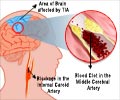Treatment and Prevention
Mild pulmonary embolism can be treated with blood thinners while severe forms will require invasive therapy. PE can be prevented through life style changes.
Pulmonary Embolism can range between mild and severe. Mild PE can be treated through anticoagulation using blood thinners, while severe PE requires additional treatments such as clot busters (thrombolytic therapy) or embolectomy, which is a procedure in which the clot is removed with the help of a catheter or surgery.
A combination of two blood thinners are used in the beginning of anticoagulation therapy. They are heparin, which is administered to the patients either intravenously or through injection, and warfarin, which is an oral blood thinner.
Heparin is available in two forms. The traditional unfractionated form has no fixed dose and requires intravenous administration. The recent forms of
Patients may need their International Normalized Ratio (INR) checked every few weeks or months to avoid side effects.
A person with PE is usually treated in the hospital while a DVT case can be managed on an out-patient basis.
In individuals who are unable to tolerate anticoagulation or in those for whom anticoagulation fails, a permanent metal filter may be inserted into the inferior vena cava (large vein below heart). This filter would then be able to stop the blood clots from reaching the pulmonary arteries and causing PE.
The drawback is that these filters do not prevent the clotting process and in turn they themselves may cause clots on or below the filter.
Prevention
Maintaining a healthy lifestyle is the best way to prevent DVT and PE. An optimal body weight, healthy diet and a consistent exercise regimen will generally reduce a person’s risk to develop venous thrombosis. Some other measures include -
- Exercise regularly. Walk, jog, bicycle, or swim to avoid inactivity.
- Limit high- caloric, high- fatty food intake.
- Drink plenty of water, avoid alcohol, walk and wear vascular compression stockings to avoid VTE while flying.
- Use nicotine patch, gum, or spray, or take bupropion to quit smoking.
- Control hypertension through lifestyle changes, self- monitoring and medications.
- Alert your doctor to your family predisposition, if any.
- If you are planning birth control or are on HRT, make sure you discuss the risks of VTE with your doctor and also, consider alternatives to these medications.
- If you are pregnant and in the high- risk category, discuss the possibility of self- administering heparin with your doctor.







